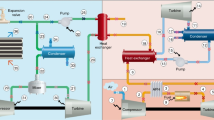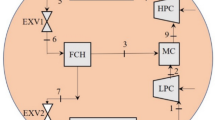Abstract
An effective thermodynamic transformation analysis method was proposed in this study. According to the phenomenon of exergy consumption always coupling with heat transfer process, the effective thermodynamic temperatures were defined, then the actual power cycle or refrigeration/heat pump cycle was transformed into the equivalent reversible Carnot or reverse Carnot cycles for thermodynamic analysis. The derived effective thermodynamic temperature of the hot reservoir of the equivalent reverse Carnot cycle is the basis of the proposed method. The combined diagram of TR-h and TR-q was adopted for the analysis of the system performance and the exergy consumption, which takes advantage of the visual expression of the heat/work exchange and the enthalpy change, and is convenient for the calculation of the coefficient of performance and exergy consumptions. Take a heat pump water heater with refrigerant of R22 for example, the proposed method was systematically introduced, and the fitting formulas of the effective thermodynamic temperatures were given as demonstration. The results show that the proposed method has advantage and well application foreground in the performance simulation and estimation under the variable working conditions.
Similar content being viewed by others
References
Wang B X. Engineering Thermodynamics (in Chinese). Beijing: Higher Education Press, 2011. 5
Shi M H, Li H L, Wang S M. Engineering Thermodynamics (in Chinese). Nanjing: Southeast University Press, 2003. 9
Zhu M S. Exergy Analysis of Energy System (in Chinese). Beijing: Tsinghua University Press, 1988
Liu Q, Duan Y Y. Exergy analysis for thermal power system of a 600 MW supercritical power unit (in Chinese). Proc CSEE, 2010, 30 (32): 8–12
Bejan A. Entropy generation minimization: the new thermodynamics of finite size and finite-time processes. J Appl Phys, 1996, 79: 1191–1218
Curzon F L, Ahlbom B. Efficiency of a Carnot heat engine at maximum power output. Am J Phys, 1975, 43: 22–24
Chen L G, Sun F R, Wu C. Finite time thermodynamic theory and applications: state of the arts (in Chinese). Prog Phys, 1998, 18(4): 404–422
Chen J C, Yan Z J. Analysis of finite time thermodynamics on a combined power cycle (in Chinese). J Xiamen Univ, 1988, 27(3): 289–293
Ma Y T, Duan R Q, Yang Z, et al. Analysis of finite time thermodynamics for refrigerating system with various temperature heat sources (in Chinese). J Eng Thermodyn, 1993, 14(4): 353–356
Author information
Authors and Affiliations
Corresponding author
Rights and permissions
About this article
Cite this article
Chen, Z., Xie, W., Hu, P. et al. An effective thermodynamic transformation analysis method for actual irreversible cycle. Sci. China Technol. Sci. 56, 2188–2193 (2013). https://doi.org/10.1007/s11431-013-5298-y
Received:
Accepted:
Published:
Issue Date:
DOI: https://doi.org/10.1007/s11431-013-5298-y




